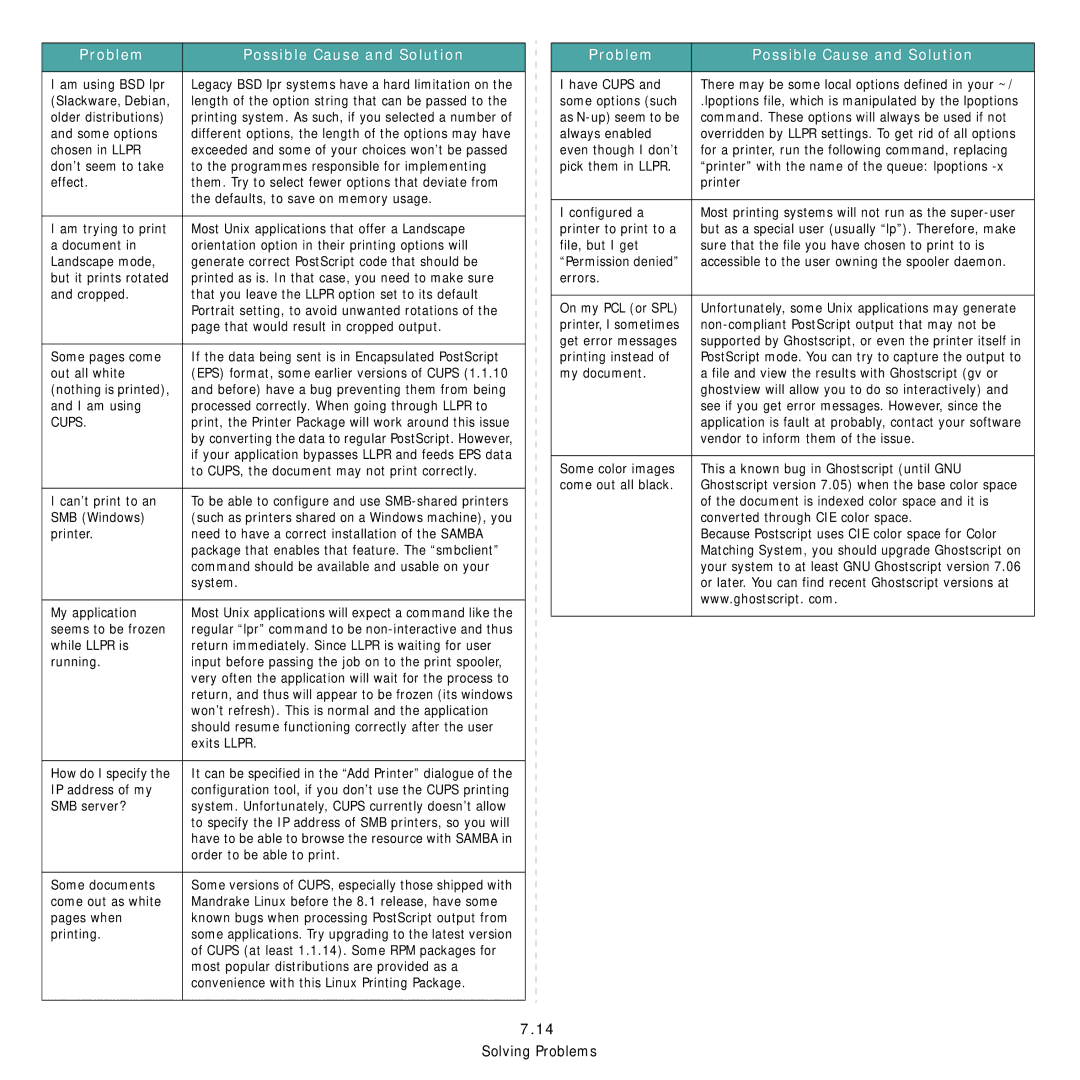
Problem | Possible Cause and Solution |
|
|
I am using BSD lpr | Legacy BSD lpr systems have a hard limitation on the |
(Slackware, Debian, | length of the option string that can be passed to the |
older distributions) | printing system. As such, if you selected a number of |
and some options | different options, the length of the options may have |
chosen in LLPR | exceeded and some of your choices won’t be passed |
don’t seem to take | to the programmes responsible for implementing |
effect. | them. Try to select fewer options that deviate from |
| the defaults, to save on memory usage. |
|
|
I am trying to print | Most Unix applications that offer a Landscape |
a document in | orientation option in their printing options will |
Landscape mode, | generate correct PostScript code that should be |
but it prints rotated | printed as is. In that case, you need to make sure |
and cropped. | that you leave the LLPR option set to its default |
| Portrait setting, to avoid unwanted rotations of the |
| page that would result in cropped output. |
|
|
Some pages come | If the data being sent is in Encapsulated PostScript |
out all white | (EPS) format, some earlier versions of CUPS (1.1.10 |
(nothing is printed), | and before) have a bug preventing them from being |
and I am using | processed correctly. When going through LLPR to |
CUPS. | print, the Printer Package will work around this issue |
| by converting the data to regular PostScript. However, |
| if your application bypasses LLPR and feeds EPS data |
| to CUPS, the document may not print correctly. |
|
|
I can’t print to an | To be able to configure and use |
SMB (Windows) | (such as printers shared on a Windows machine), you |
printer. | need to have a correct installation of the SAMBA |
| package that enables that feature. The “smbclient” |
| command should be available and usable on your |
| system. |
|
|
My application | Most Unix applications will expect a command like the |
seems to be frozen | regular “lpr” command to be |
while LLPR is | return immediately. Since LLPR is waiting for user |
running. | input before passing the job on to the print spooler, |
| very often the application will wait for the process to |
| return, and thus will appear to be frozen (its windows |
| won’t refresh). This is normal and the application |
| should resume functioning correctly after the user |
| exits LLPR. |
|
|
How do I specify the | It can be specified in the “Add Printer” dialogue of the |
IP address of my | configuration tool, if you don’t use the CUPS printing |
SMB server? | system. Unfortunately, CUPS currently doesn’t allow |
| to specify the IP address of SMB printers, so you will |
| have to be able to browse the resource with SAMBA in |
| order to be able to print. |
|
|
Some documents | Some versions of CUPS, especially those shipped with |
come out as white | Mandrake Linux before the 8.1 release, have some |
pages when | known bugs when processing PostScript output from |
printing. | some applications. Try upgrading to the latest version |
| of CUPS (at least 1.1.14). Some RPM packages for |
| most popular distributions are provided as a |
| convenience with this Linux Printing Package. |
|
|
Problem | Possible Cause and Solution |
|
|
I have CUPS and | There may be some local options defined in your ~/ |
some options (such | .lpoptions file, which is manipulated by the lpoptions |
as | command. These options will always be used if not |
always enabled | overridden by LLPR settings. To get rid of all options |
even though I don’t | for a printer, run the following command, replacing |
pick them in LLPR. | “printer” with the name of the queue: lpoptions |
| printer |
|
|
I configured a | Most printing systems will not run as the |
printer to print to a | but as a special user (usually “lp”). Therefore, make |
file, but I get | sure that the file you have chosen to print to is |
“Permission denied” | accessible to the user owning the spooler daemon. |
errors. |
|
|
|
On my PCL (or SPL) | Unfortunately, some Unix applications may generate |
printer, I sometimes | |
get error messages | supported by Ghostscript, or even the printer itself in |
printing instead of | PostScript mode. You can try to capture the output to |
my document. | a file and view the results with Ghostscript (gv or |
| ghostview will allow you to do so interactively) and |
| see if you get error messages. However, since the |
| application is fault at probably, contact your software |
| vendor to inform them of the issue. |
|
|
Some color images | This a known bug in Ghostscript (until GNU |
come out all black. | Ghostscript version 7.05) when the base color space |
| of the document is indexed color space and it is |
| converted through CIE color space. |
| Because Postscript uses CIE color space for Color |
| Matching System, you should upgrade Ghostscript on |
| your system to at least GNU Ghostscript version 7.06 |
| or later. You can find recent Ghostscript versions at |
| www.ghostscript. com. |
|
|
7.14 Solving Problems
